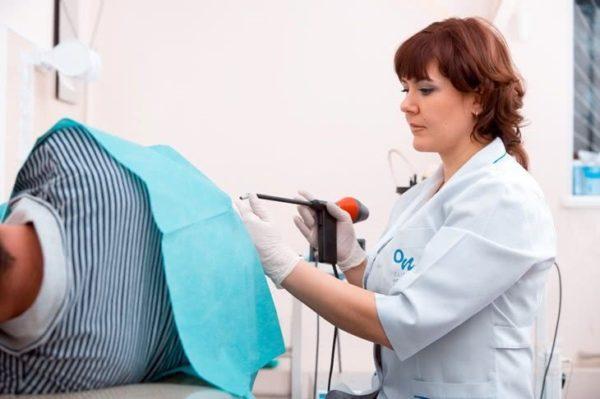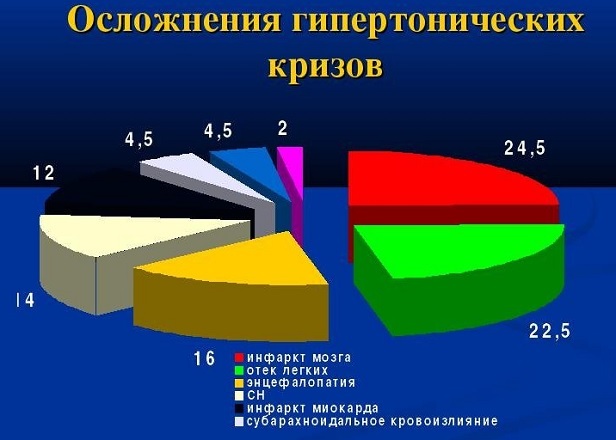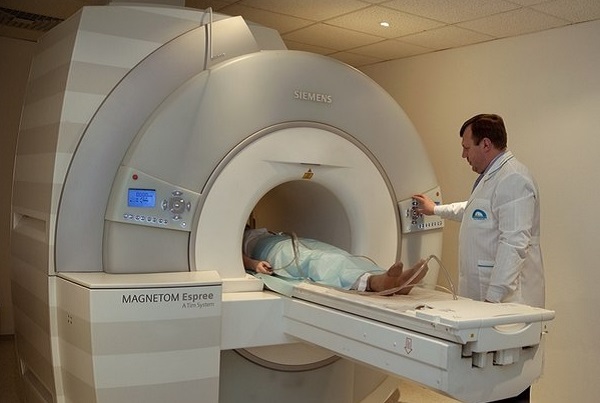Rectoscopy: what is it, how is the procedure done, how to prepare
When problems arise with the intestines, and the doctor prescribes a special procedure for examining this organ, the question arises: rectoscopy is what. This term refers to a procedure for examining the rectum and end sections of the sigmoid colon. The examination is performed using a rectomanoscope. Diagnostics allows you to identify inflammation, tumor formations, stenosis and other pathologies. With a colonoscopy, the area of study moves closer to the stomach and refers to the entire colon. The indications for the use of endoscopy and the way they are performed differ.

Diagnostic method for assessing the condition of the intestine
Content
-
1 What is rectoscopy
- 1.1 Video - Rectoscopy: what is this procedure, how to prepare for it
- 2 How to do rectomanoscopy
-
3 How to prepare for the procedure
- 3.1 Special diet
- 3.2 Mechanical cleaning
- 4 What is the Difference Between Rectoscopy and Colonoscopy
What is rectoscopy
This type of endoscopic examination implies a detailed study of the state of the mucous membrane of the entire rectum and the end sections of the sigmoid. In general, up to 30 cm of the intestine can be examined with the help of the apparatus.
Performed with a rectomanoscope. It is a hollow instrument with a certain degree of flexibility. Air is pumped into it at the beginning of the study, after which the eyepiece is carefully inserted. With the help of an illuminated eyepiece, a gastroenterologist or endoscopist carefully examines the condition of the patient's mucosa.

Rectomanoscope appearance
Rectoscopy is shown for:
- tumors: good and malignant, polyps;
- inflammation;
- ulcer;
- stenosis;
- in the postoperative period to assess the condition of the sutures.
The procedure rarely causes pain in the patient and has practically no contraindications to its implementation. However, the presence of severe bleeding from the intestine, cracks in the anus, acute inflammation and pronounced narrowing of the intestine (congenital or acquired characters) is a contraindication for rectoscopy. Before performing the procedure, these states must be brought into a state of remission.

Histological drawing and explanation of the location of the anus
Video - Rectoscopy: what is this procedure, how to prepare for it
How to do rectomanoscopy
Procedure execution:
- Body position on the left side. It is necessary to bend the bent legs as close to the chin as possible. Another type of position is allowed: in the knee-elbow position.
- Take a deep breath and exhale, slowly relax your right shoulder and neck. When inhaled, the doctor inserts a rectomanoscope through the anus, alternately inflating it with a pear.
- After that, an eyepiece is inserted into the tube and the mucous membrane is examined.
- To pass into the lower third of the sigma, take a deep breath again and gradually, relaxing, exhale. The doctor slowly, as if twisting, introduces the apparatus deeper into the intestines.

Rectomanoscopy
Be sure to use a lubricant, such as petroleum jelly or any other indifferent ointment. The rectomanoscope together with the obturator is inserted only 4-5 cm. Further, it is extracted and visually studied. The transition from the straight to the sigmoid colon is located in the region of 12-14 cm from the anus. When penetrating into this section of the large intestine, the doctor pumps air with a pear to alleviate the patient's condition.
Rectomanoscopy examines the posterior third of the sigmoid colon and rectum, up to the anus. To study the latter, it is better to use an anoscope.

Anoscope
For accurate registration of the detected pathologies in the mucous membrane of the end sections of the intestine, a "clock dial scheme" is used:
| Clock position | Topography |
|---|---|
| 6 | From the anus towards the tailbone (taking into account the position on the back) |
| 12 | Towards the suture of the scrotum in men and the labia in women. |
| 9 | On the right side of the anus |
| 3 | From the left side |
The line that connects all positions of the watch corresponds to the middle of the anus. In this case, there is a division into anterior and posterior semicircles. The research takes about 10 minutes.

Schematic representation of sectors for research
If after rectomanoscopy bleeding appears, severe pain, an urgent need to inform the attending physician about it. These symptoms can occur with a biopsy, a polyp removed, or a breakthrough in the intestinal wall. A ruptured bowel requires an urgent operation.
How to prepare for the procedure
Special diet
Preparation for rectomanoscopy is based on bowel cleansing and diet. All these activities begin 2-3 days before the examination. Foods with a high fat content are excluded from the diet, contributing to increased gas production, constipation, or, conversely, frequent stools.

Vegetable soups are quickly absorbed by the body and cleanse the intestines well
Exclude:
- meat and fish;
- vegetables and fruits;
- all bakery and pasta;
- confectionery with cocoa;
- spices;
- canned food.
From drinks you cannot:
- strong black tea and coffee;
- carbonated;
- alcohol;
- juice in bags.
Food should be steamed or boiled. Also exclude spicy, fried and smoked. Dishes with a low kcal content should be easily and quickly absorbed by the body. Frequent, fractional meals in small portions are optimal for the body in this case. It is better to drink plain water, or green tea or herbs.
Of the products used, it is allowed to eat meat and fish with a low fat content, dairy and fermented milk products with a low% fat content. You can make broths from vegetables.
Menu for 1 day:
- Breakfast: oatmeal porridge, a slice of bread with cheese, tea.
- Lunch: kefir or fermented baked milk, 200 ml, 3-4 biscuits.
- Lunch: meat soup or fish, baked vegetables, 1-2 slice of dry bread, tea.
- Afternoon snack: low-fat cottage cheese casserole with a little honey.
- Dinner: boiled vegetables with a little chicken.
- Before going to bed: a glass of kefir.

Approximately such a low-calorie diet should be followed for 2-3 days. The day before the examination, the food should be even more lean. Dinner and meals before bedtime will need to be discarded. After 4-6 hours after the last meal, you will need to perform an enema. Do not be surprised if you lost a little weight, since nutrition for 2-3 days was supportive and cleansing.
Mechanical cleaning
Of the cleansing procedures, the most effective are:
- enema: performed in the evening before endoscopy and in the morning, immediately before rectomanoscopy;
- medicines: Fortrans, Mikrolax.
Enema

Esmarch device with all the important attributes for bowel cleansing
Enema stages:
- Drink magnesium or water.
- 1.5 liters of water is poured into Esmarch's container, about 24.
- The tip of the tube inserted into the anus is lubricated with petroleum jelly or simple baby cream.
- Raises the water container to a height of about 1 meter.
- The patient lies on his side, with the legs pressed to the thighs.
- They are introduced gently, gradually draining the water.
- To prevent air from entering, part of the liquid in the mug should be left.
The urge to defecate occurs almost immediately. Until the complete absence of symptoms, the patient undergoes mechanical cleansing. To improve your overall well-being, you can stroke your belly clockwise.
Do you suffer from constipation? Find out what's special microclystersand how they help get rid of the disease.
Fortrans
Fortrans is a laxative used to empty the large intestine. The need for use arises before endoscopy, X-ray, or surgery.

Appearance of the drug
Fortrans has a number of limitations:
- up to 15 years old;
- malignant neoplasms with a large lesion area;
- intolerance to polyethylene glycol;
- decompensation stage;
- violation of intestinal patency: complete and chatsic.
Fortrans is a white powder that dissolves quickly in water. 1 sachet per liter of water, calculated per 20 kg body weight. An adult's body usually requires 3-4 sachets. The dissolved mixture is drunk once, or divided into 2 doses. Use no later than 10-12 hours before the procedure.
In older people, especially in the presence of a large number of pathologies, the use of Fortrans should be supervised. During pregnancy and lactation, it is allowed to use it only if necessary.
Side effects included dyspeptic symptoms (nausea, vomiting, flatulence), rash, and swelling of the skin. Such signs are extremely rare, and their single occurrence is an indication to stop using Fortrans.
Microlax

Fast acting laxative
An excellent laxative with a combined type of action. Represents microclysters, 5 ml each.
Use is recommended for constipation and preparation for endoscopy. Microlax is allowed even in newborns.
Features of use:
- Take out the tube, break off the tip and squeeze out the contents slightly to facilitate insertion.
- Introduce slowly into the intestine: in children from 3 years of age and in adults at full length, up to 3 years by half.
- After squeezing out all the contents, slowly remove
- The first urge to defecate occurs within 5-15 minutes
The drug acts due to citrate and Na lauryl sulfoacetate, sorbitol. The binding of excess water, the dissolution of feces and the acceleration of peristalsis are distinguished by Microlax. An empty intestine, cleansed with healthy food, enemas and medications, will be perfectly visualized by the doctor during rectoscopy.
What is the Difference Between Rectoscopy and Colonoscopy
Rectoscopy and colonoscopy are diagnostic endoscopy techniques, during which the condition of the large intestine is assessed. However, there are significant differences between the topography and the technique used.
Rectomanoscopy allows you to assess the condition of the entire rectum and the lower part of the sigmoid. Colonoscopy allows you to examine the entire colon, including the caecum-shaped end-piece.

Colonoscope illumination can detect intestinal polyps
By hardware:
- rectoscopy: a fairly rigid eyepiece, installed with the help of air and a rectoscope. The maximum examination distance from the anus is up to 30 cm;
- colonoscopy: flexible fiber optics, with display of results on the screen.

Colonoscopy demonstration
Which is the best procedure? It all depends on what exactly is required to be examined. With a colonoscopy, you can better assess the condition of the mucous membrane. If necessary, the results can be recorded on a digital carrier in the form of a photo and video, as well as printed.

Options for diagnosing pathology using a colonoscope
With rectoscopy, it all depends on the skill of the doctor, since only a visual examination is carried out. In this case, the use of this method is justified in case of suspicion of the location of the pathology in the rectum or in the distal third of the sigmoid.
What is the doctor based on when choosing this or that method? Of course, on the symptoms and test results.
Symptomatic differences between endoscopic examinations:
| Rectomanoscopy | Colonoscopy |
|---|---|
| Frequent constipation, with disturbances in the frequency of bowel movements and the amount of stool | Sharp soreness in the lower abdomen, with irradiation to the end sections of the rectum |
| Discharge from the anus: not only mucous, but also bloody in nature | Rapid weight loss |
| Prolonged hemorrhoids | Tumor and Crohn's pathology |
| Tumor | Frequent bleeding from the anus |
| Stenosis | Asthenic signs |
| Ulcers | Anemia |
| Polyps |
Colonoscopy refers to more informative diagnostic methods. Due to the technical capabilities, it is possible to perform not only diagnostics (including biopsy), but also treatment (washing, applications, cauterization).
There is also a concept in endoscopy, rectosigmocolonoscopy. With this research method, 1 apparatus can be used to examine the mucosa throughout the entire large intestine, sigmoid and rectum. Biopsy, conservative treatment can be performed on any part of the intestine.
When choosing between rectanoscopy and colonoscopy, the more informative method is preferred. However, in some cases, both types of endoscopy are used. For example, during colonoscopy, the end section of the rectum is not visible. Therefore, the relevance of rectomanoscopy always remains.
Rectoscopy refers to a popular method of examining the mucous membrane of the rectum and the lower third of the sigmoid. For research, a rectomanoscope with an eyepiece is used. The procedure is practically painless and very informative in terms of identifying pathologies in that particular part of the intestine.



